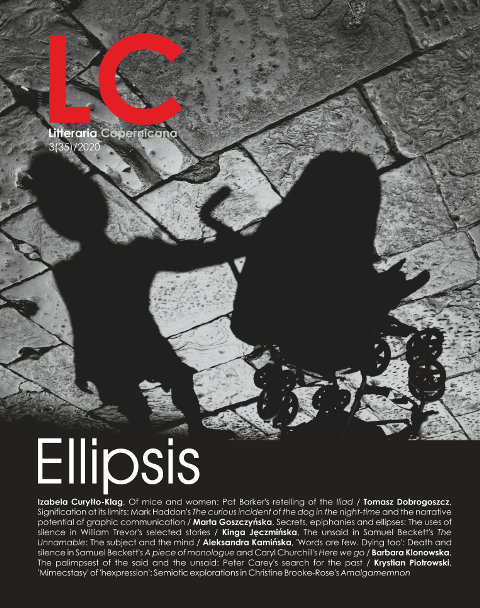The Palimpsest of the Said and the Unsaid: Peter Carey’s Search for the Past
DOI:
https://doi.org/10.12775/LC.2020.032Słowa kluczowe
ellipsis, metonymy, allusion, meta-history, Peter CareyAbstrakt
The article explores strategies of elliptical writing in The Chemistry of Tears (2012) by Peter Carey, a novel concerned with the presentation of the processes of concealing and revealing the troublesome past and its connections with the present. It argues that, systematically oscillating between the secret and the revealed, the novel tries to negotiate its way through the palimpsest of the past to re-construct the versions so far unrepresented. The narrative introduces and then slowly fills in narrative gaps, omissions and allusions, becoming a dramatisation of the elliptical strategies of prose. The first level of the operation of elliptical strategies concerns personal stories of characters; the next is represented by larger history and its ramifications for the present; while the last includes historiography and literary tradition. In the centre of the numerous layers of the text and its parallel plots stands the central image of the automaton connected with the process of revelation and restoration: it encapsulates the novel’s elliptical strategies by filling in various textual gaps and yet simultaneously hinting at the impossibility of any such operation.
Artykuł bada eliptyczne strategie pisania zastosowane w Chemii łez (2012) Petera Carey’a – powieści, która koncentruje się na problemach ukrywania i ujawniania problematycznej przeszłości i jej związków ze współczesnością. Dowodzi on, iż oscylując między tym, co ukryte i co ujawnione, powieść próbuje przedrzeć się poprzez palimpsest przeszłości i zrekonstruować jej dotychczas niereprezentowane wersje. Powieść wprowadza, a następnie wypełnia szereg luk, niedopowiedzeń i aluzji, fabularyzując tym samym eliptyczne strategie, którymi się zajmuje. Ich pierwszy poziom to dzieje bohaterów; drugi – to szerzej rozumiana przeszłość i jej konsekwencje dla współczesności; ostatni to problematyka historiografii i gry z literacką tradycją. W centrum tych licznych warstw i równoległych wątków stoi centralna figura automatu, który niczym zwornik wiąże tematy ujawniania i przywracania, zbiera w sobie eliptyczne strategie powieści i poprzez wypełnienie narracyjnych luk, jednocześnie wskazuje na niemożliwość takich operacji.
Bibliografia
Andersen, Hans Christian 2014. “The Ugly Duckling”. The Complete Fairy Tales. Translated by Jean Hersholt. San Diego: Baker and Taylor. 165–170.
Carey, Peter 2012. The Chemistry of Tears. London: Faber and Faber.
Daniel, Linda 2012. Rev. of The Chemistry of Tears by Peter Carey. The Telegraph, 23 March 2012. on-line.
Eco, Umberto 1979. The Role of the Reader. Explorations in the Semiotics of Texts. Bloomington: Indiana University Press.
Fryer, David M. and John C. Marshall 1979. “The Motives of Jacques de Vaucanson”. Technology and Culture 20, 2: 257–269.
Hansson, Heidi 1998. Romance Revived. Postmodern Romances and the Tradition. Uppsala: Swedish Science Press.
Ingarden, Roman 1979. The Literary Work of Art: An Investigation on the Borderlines of Ontology, Logic and Theory of Literature. Translated by George G. Grabowicz. Evanston: Northwestern University Press.
Iser, Wolfgang 1971. “The Reading Process: a Phenomenological Approach”. New Literary History 3: 279−299.
LaCapra, Dominic 2001. Writing History, Writing Trauma. Baltimore: The Johns Hopkins University Press.
Lodge, David 1992. The Art of Fiction. London: Penguin.
Rimmon-Kenan, Shlomith 1983. Narrative Fiction: Contemporary Poetics. London: Methuen.
Šlapkauskaitė, Rūta 2017. “Of Motion and Emotion: The Mechanics of Endurance in Peter Carey’s The Chemistry of Tears”. Anglica 26, 1: 101–118.
Todorov, Tzvetan Poetyka. 1984. Translated by Stanisław Cichowicz. Warszawa: Wiedza Powszechna.
Virilio, Paul 2012. The Great Accelerator. Translated by Julie Rose. Cambridge: Polity.
Pobrania
Opublikowane
Jak cytować
Numer
Dział
Statystyki
Liczba wyświetleń i pobrań: 677
Liczba cytowań: 0



